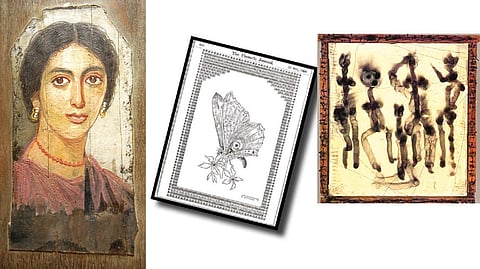

CHENNAI: For centuries artists have tried to imitate life through surrealistic representations of how they perceive the world. And in that endeavour have developed creations that have stood the test of time inspiring generations of creative minds to study, replicate and interpret. But as you look deeper into the essence of the lifecycle of creative expression you will find a foundation that’s based on various classifications of technique and style.
These techniques have been brought to the fore by movements that have defined eras in art history. There are still some techniques that haven’t been given their well-earned share of time in the sun but do present incredible possibilities for artists, curators, and admirers alike.
Fumage Art
Invented in the 1930s by Austrian surrealist artist Wolfgang Palen, Fumage Art is the technique of delicately using the soot or the traces of black carbon of the flame of a lit candle as a brush or pencil. The result of this careful technique is designs and images that have an unworldly, almost dreamlike feel as perfectly depicted in Palen’s 1941 creation the Messenger that features a floating ghostly form painted with smoke onto a base of wet paint. While relatively unheard of, this technique is almost prehistoric given its use by cavemen.
Anamorphosis
Anamorphic art is the peculiar style of creating distorted portraits that can only be viewed in their true form, from specific angles and perspectives. Artists have played with this technique for centuries and in some instances have even utilised mirrors and reflections in order to present an accurate view of the creation to their audience. The beginning of this incredible technique can actually be traced back to Leonardo Da Vinci’s notebooks in the 15th century.
Typewriter Art
A little over two decades after the first manufactured typewriter made its public debut, the first piece of typewriter art was created by British secretary Flora Stacey in 1898. A beautifully constructed butterfly made of brackets, dashes, slashes, and asterisks, this simple yet revolutionary creation at the time spurred on a deluge of artists experimenting with the humble typewriter to create works that were truly inspired. Among these artists emerged a man who was unequivocally known worldwide as the “Typewriter Artist,” Paul Smith who elevated the style to create picturesque scenes and portraits that exemplified impeccable skill and imagination.
Encaustic painting
Encaustic painting utilises hot beeswax tinted with colour pigments to etch and apply onto a hardened surface which more often than not is wood but has also been used on canvas or metal.
Visit news.dtnext.in to explore our interactive epaper!
Download the DT Next app for more exciting features!
Click here for iOS
Click here for Android